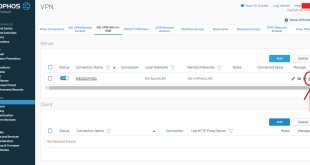Sophos SSL VPN Client is a widely used tool for secure remote access to corporate networks. However, there are instances where users may encounter issues with this client, leading to a failed connection. In this blog post, we will explore the common problems faced by users and provide solutions to overcome them.
Users of the Sophos SSL VPN Client may face a range of challenges when trying to establish a connection. These can include authentication failures, slow connection speeds, or the inability to connect at all. Such issues can disrupt workflow and cause frustration for users.
The primary target of Sophos SSL VPN Client failure is to address the challenges faced by users and provide effective solutions. By understanding the common problems and implementing appropriate measures, users can overcome these obstacles and ensure a smooth and secure VPN connection.
In summary, when using the Sophos SSL VPN Client, it is important to address any potential issues that may arise. By understanding the common problems faced by users and implementing appropriate solutions, users can ensure a stable and secure VPN connection. By following best practices and troubleshooting techniques, users can mitigate the risk of encountering further problems.
Table of Contents
Sophos SSL VPN Client Failure: Explained
When it comes to Sophos SSL VPN Client failure, users may find themselves struggling to establish a secure connection to their corporate network. This can have detrimental effects on productivity and hinder the ability to work remotely. In this section, we will delve deeper into the reasons behind these failures and explore ways to resolve them.
One of the main reasons for Sophos SSL VPN Client failure is incorrect configuration settings. Users may face issues if the client is not properly configured to match the VPN server’s specifications. Additionally, outdated or incompatible software versions can also cause connection failures. It is crucial to ensure that both the client and server are running the latest software versions to avoid any compatibility issues.
In some cases, network connectivity problems can also contribute to VPN client failures. Issues such as unstable internet connections, network congestion, or firewall restrictions can prevent the client from establishing a successful VPN connection. Users should check their network settings and troubleshoot any connectivity issues to resolve this problem.
The History and Myth of Sophos SSL VPN Client Failure
The history of Sophos SSL VPN Client failure dates back to its inception, with early versions of the client riddled with bugs and compatibility issues. Over time, however, Sophos has made significant improvements to the client’s reliability and performance, addressing many of the previous challenges. Despite these efforts, there still may be instances where users encounter failures due to various reasons.
One common myth surrounding Sophos SSL VPN Client failure is that it is solely caused by the client itself. While the client software can contribute to connection issues, it is important to consider other factors such as network settings, server configurations, and user error. By taking a holistic approach to troubleshooting and addressing all potential contributors, users can resolve SSL VPN Client failures effectively.
The Hidden Secret of Sophos SSL VPN Client Failure
The hidden secret behind Sophos SSL VPN Client failure lies in understanding the underlying factors that contribute to these issues. It is essential to recognize that VPN client failures can stem from various sources, including software conflicts, network restrictions, or authentication problems. By carefully examining the logs and error messages generated by the client, users can uncover the hidden secrets behind these failures and implement appropriate solutions.
Recommendation for Sophos SSL VPN Client Failure
When faced with Sophos SSL VPN Client failure, it is important to follow recommended practices to resolve any issues. Some key recommendations include:
- Ensure that the client and server software are up to date and running compatible versions.
- Double-check the VPN configuration settings to match the server’s specifications.
- Verify network connectivity and troubleshoot any network-related issues.
- Consult the Sophos support community or contact the support team for further assistance.
By following these recommendations, users can minimize the risk of SSL VPN Client failures and ensure a smoother and more secure remote access experience to their corporate networks.
Sophos SSL VPN Client Failure: Explained in Detail
Sophos SSL VPN Client failure can manifest in different forms, each with its own set of challenges. Some common issues faced by users include:
1. Authentication Failures: Users may encounter authentication failures when trying to establish a VPN connection. This can be due to incorrect login credentials or expired user accounts. By double-checking the login details and ensuring that accounts are active, users can overcome this hurdle.
2. Network Connectivity Problems: Slow connection speeds or the inability to connect at all can be indicative of network connectivity problems. Users should check their internet connection, router settings, and firewall configurations to resolve these issues.
3. Software Compatibility Issues: Outdated or incompatible versions of the client software can lead to connection failures. Users should ensure that both the client and server software are running the latest versions to avoid compatibility issues.
4. Firewall Restrictions: Network firewalls can sometimes block VPN connections. Users should check their firewall settings and configure them to allow VPN traffic for a successful connection.
Tips for Overcoming Sophos SSL VPN Client Failure
When facing Sophos SSL VPN Client failure, there are several tips that users can follow to overcome the challenges:
- Ensure that the client software is installed correctly and all necessary components are present.
- Double-check VPN configuration settings to match the server’s requirements.
- Restart the client software and try establishing a connection again.
- Restart the computer and any network devices to reset network connections.
By implementing these tips, users can troubleshoot and overcome common issues associated with Sophos SSL VPN Client failure.
Conclusion of Sophos SSL VPN Client Failure
In conclusion, Sophos SSL VPN Client failure can pose various challenges for users trying to establish a secure remote connection. By understanding the common problems, addressing the underlying causes, and following recommended practices, users can overcome these issues and ensure a smooth and reliable VPN experience. It is essential to stay updated with the latest client and server software versions, configure the VPN settings correctly, and troubleshoot any network connectivity issues to minimize the risk of SSL VPN Client failures.
 cobabybarcelona Latest Updated Live News cobabybarcelona
cobabybarcelona Latest Updated Live News cobabybarcelona



